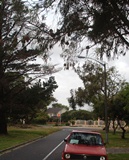Weaver species
Choose different species from drop-down list and press 'Go' button. See Full species list.Loanga Weaver Ploceus subpersonata
IUCN: Vulnerable Discovery: 071Categories: IUCN, Ploceus 5: 'Sitagra', palm,
News items about species
Discovery
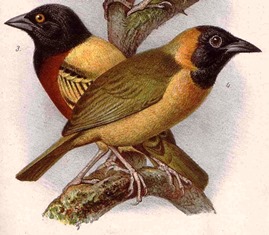
figure from Reichenow (1886) 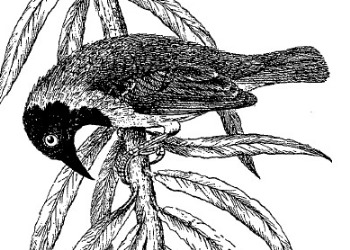
figure from Bannerman (1949) 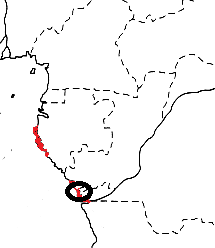
distribution, type locality circled IntroductionThe Loanga Weaver was formally described by Jean Louis Cabanis, a German ornithologist. He described 19 weavers, of which 3 are valid weaver species, while working at the Berlin Museum.The Loanga Weaver was collected by Julius Falkenstein, a German physician, who was based in Cabinda from 1873-76. One of his companions on the German Loango Expedition was Paul Gussfeldt who wrote a travel book about this expedition. They explored Cabinda and surrounding DRC. In addition to collecting bird specimens, Falkenstein sent the second gorilla specimen back to Europe. The first illustration of the Loanga Weaver was published in Reichenow (1886). The next illustration relating to this species was a sketch of a male published in Bannerman (1949). The female was collected as late as 1951, described by Chapin (1954), and first illustrated by Westoll (1998). Scientific citationHyphantornis subpersonata Cabanis 1876, J. Orn., 24, p.92 Chinchoxo, Cabinda.Meaning of namessubpersonatus, Latin: sub-, related to; personatus, masked; ref. relationship of this weaver to other masked weavers.First English nameLoango Slender-billed Weaver (Shelley 1905).Alternate namesLoanga Slender-billed Weaver, Loango Slender-billed Weaver, Loango Weaver, Western Golden Weaver.CollectorDr Julius Falkenstein.Date collectedBetween 1873-76.Locality collectedChinchoncho = Chinchoxo, Cabinda, Angola.Type specimensThere should be a type specimen in the Berlin Museum but it was not seen on a visit there. |
The above is based on Weaver Wednesday 2, a weekly series about the discovery of each weaver species.
This species text first appeared as
Weaver Wednesday [188] - Discovery [71]: Loanga Weaver on 2016-01-20
1. Basic biology

Reichenow 1886 (Black-headed Weaver behind) 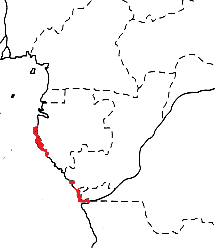
Distribution. The Loanga Weaver is restricted to a narrow coastal strip on the west coast of Africa from Gabon south through Congo, extreme south-west DRCongo and Cabinda (Angola, where the type specimen was collected) (see red on map right, based on Birds of Africa). In 2007 it was also recorded in northern Angola. Having a restricted global range, no subspecies are recognised. The Loanga Weaver is rated as Vulnerable (one of 6 weavers are in this category) because it is a very poorly known species. Recent surveys, however, suggest that its range may possibly be more extensive, and its numbers may be larger, than previously thought. The Loango Weaver may be able to survive in urban or suburban areas, although at lower densities than the more common Slender-billed Weaver.
Habitat. The Loanga Weaver is usually found near water and inhabits swamp-forest, mangrove and savanna margins on the landward side, palm savanna and clearings in secondary forest, generally within 3 km of the coast; it also occurs in thick spiny palms and beach scrub. It is shy and skulking. Food.
The diet of the Loanga Weaver is unknown, but its slender bill suggests that it is mainly insectivorous.
Breeding. The Loanga Weaver nests in a variety of trees, especially palms Phoenix reclinata, but also mangroves and once in a Eucalyptus tree. The breeding season seems to be either irregular or spread throughout the year. Nests have a retort shape, with an entrance tube of about 10 cm long. Much of this breeding information is based on a recent study of the species by Guillaume Passavy (see here). One egg in the British Museum was described as greyish-buff, spotted brown mainly round the large end (Walters 2006a). |
The above is based on Weaver Wednesday, a weekly series about weaver species.
This species text first appeared as
Weaver Wednesday [57]: Loanga Weaver on 2013-07-17
2. Breeding facts
| Pair bond no information Breeding season no information Nest site Reported as nesting in Phoenix reclinata and Caesalpinia bonduc, but no details Nest building no information Colony size no information Clutch size no information Egg colour no information Egg size no information Incubation no information Chicks and nestling period no information |
Breeding information based on Handbook of the Birds of the World, Vol. 15.
3. Photos of Weaver Nests
 Vm 13824 |  Vm 2008 |  Vm 2007 |
Thumb-nails of most recent PHOWN records - click on one to see its full record
See all PHOWN records for this species here.
PHOWN (Photos of Weaver Nests) provides valuable info on breeding distribution and colony sizes of weavers.
You can contribute by registering and submitting photos at Virtual Museum webpage.
4. Breeding distribution
Google map showing distribution (For species with small ranges you need to zoom in at the correct area to see the range):
yellow blob - range of weaver species; read more about this here.
![]() - PHOWN records with photos
- PHOWN records with photos
![]() - PHOWN records with no photos (Nest Record Cards, other records)
- PHOWN records with no photos (Nest Record Cards, other records)
![]() - Birdpix records
- Birdpix records
![]() - comments on out of range records, or interesting records
- comments on out of range records, or interesting records
![]() - type locality
- type locality
CLICK on the marker on the map to see individual record details.
5. Range changes
Not South African speciesThe above is based on Weaver Wednesday 3, a weekly series about range changes in South African weaver species.
This species text first appeared as
n/a








